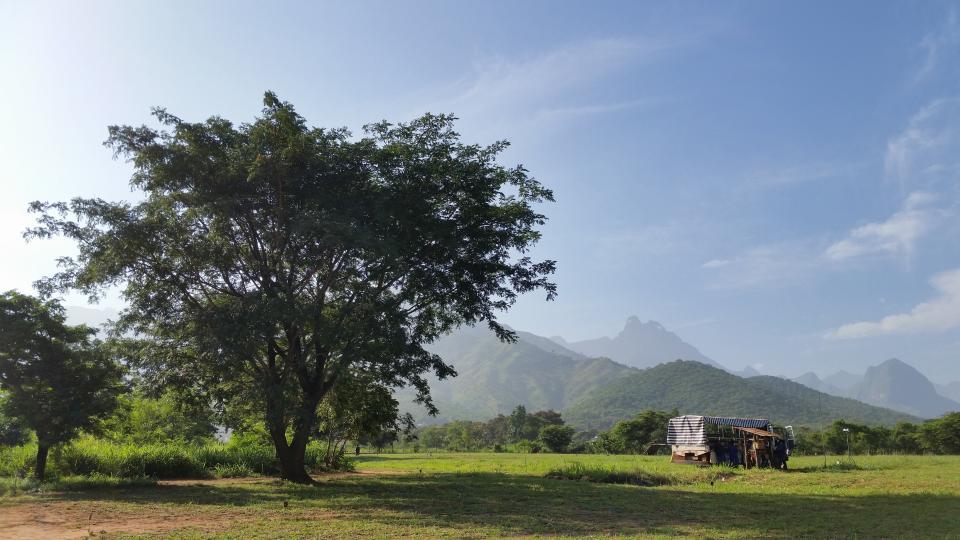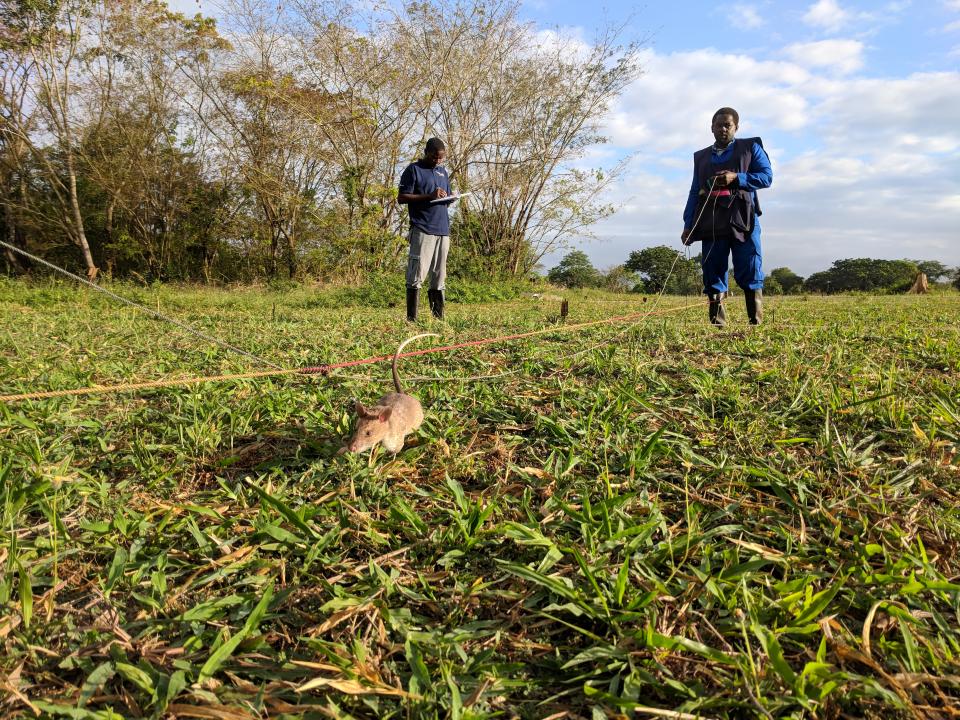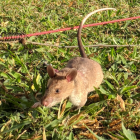Discussions about “envirotech” trouble the purported opposition between technology and nature. They call attention to the many ways that nature is changed, sensed, and reimagined through an assemblage of technologies and sociotechnical systems. What are taken to be natural phenomena often belie complex social and technological interventions. Such envirotechnical analyses attune historians to the social and political contingencies that alter and configure relations between humans, nature, and technology.
Envirotechnical analyses have seldom, however, considered those systems, tools, and techniques for transforming nature into environment that are also living organisms. What insights could model organisms, sniffer dogs, and sentinel species raise when considered as technologies? To suggest some answers, I consider an international NGO project in Morogoro, Tanzania, where a group of people train African giant pouched rats (Cricetomys ansorgei) in order to transform them into sensing technologies for detecting landmines.

Photograph of the training fields, where deactivated landmines are buried, January 2018.
Photograph of the training fields, where deactivated landmines are buried, January 2018.
Photograph by Jia Hui Lee, 2018.
 This work is licensed under a Creative Commons Attribution 4.0 International License.
This work is licensed under a Creative Commons Attribution 4.0 International License.
Since 1997, APOPO has trained rats in Tanzania, which are then deployed in Angola, Cambodia, and until 2015, Mozambique, to help clear landmines and other unexploded ordnances (UXOs). As anthropologist Darcie DeAngelo has noted, the animal qualities of these rats, particularly their “cuteness,” have upended military norms that define disarmament work. APOPO’s center in Siem Reap, Cambodia, welcomes visitors to interact with these trained rodents, who are often portrayed wearing hats and have garnered a following on social media. Such cuteness further “demilitarizes” mine clearance beyond earlier efforts in the 1990s to establish “humanitarian mine clearance.”
These rodents (panya buku in Kiswahili), however, were not always considered cute. When I conducted ethnographic interviews with trainers in Tanzania about their own induction into rodent training, trainers recalled how they thought rats were “dirty” or “disgusting” creatures. Like many inhabitants of Morogoro, they considered rodents pests and disease carriers, and occasionally, food. It was only through long-term training—as well as other labors of care, such as cleaning, feeding, and playing—that trainers would develop a fondness for the rodents with whom they work. In other words, “cuteness” has a history, and it is this quality that comes to represent a new kind of human-rodent relation. Rodents become “cute” when they are no longer treated as pests, disease carriers, or bushmeat. It is this process of transformation that I focus on within the context of envirotech analyses.
Video of the early stages of rat training in action. APOPO, January 2017.
Among environmental historians, the idea that animals are technology has spurred spirited debate, giving rise to the subfield of “evolutionary history,” which, as elaborated by Edmund Russell, takes a longer historical view of human practices in selecting, shaping, and sequencing nature through practices of breeding, agriculture, and other industrial modes of meat and crop production. “Evolutionary” is certainly one way of thinking about histories of domestication that involve gradual, contingent changes over long periods of time and that implicate both humans and other animals. The problem posed by landmine-detecting rats, however, is that their transformation into “sensing technologies,” as they are known to trainers and to the organization, takes place within the span of a single lifespan.
As such, “domestic” does not quite describe these rats either. Trainers do not consider them as being in the same category as the chickens, goats, and dogs that they keep at home. Trained rodents are also considered different from “wild,” untrained rodents, whose behaviors are more erratic and aggressive. What conceptions of “technology,” then, are being invoked when trained rodents are designated as such, or when they are praised as “machines” [mashine in Kiswahili] for performing well in the field?
The training process begins when a young rat is weaned from its mother. It then spends several hours a day in close contact with trainers, becoming accustomed to human sensory worlds: odors of sweat, clothing, and gasoline; sounds of footsteps, engines, and human conversation. For eight months, the rats are taught to associate food with the odor of trinitrotoluene, or TNT, a chemical found in many explosives. They learn to seek out TNT odors and indicate their presence to their human counterparts. Trainers must learn to read rodent behaviors, so that they can know with certainty when a rodent signals a landmine.

A giant pouched rat (Cricetomys ansorgei) being trained by trainers in Morogoro, Tanzania, in mine fields with deactivated mines.
A giant pouched rat (Cricetomys ansorgei) being trained by trainers in Morogoro, Tanzania, in mine fields with deactivated mines.
Photograph by Jia Hui Lee.
 This work is licensed under a Creative Commons Attribution 4.0 International License.
This work is licensed under a Creative Commons Attribution 4.0 International License.
Rodent trainers in Tanzania draw on vast experiences and knowledge of rodent nature to intervene in the animals’ development and transform them into sensing technology. This knowledge is emplaced and specific to the very interspecies relationships that make training possible. Rodent training as a gradual, unfolding process that enable humans and rats to work together to detect landmines, therefore, is a process of history making. Here, I am reminded of the etymological dimensions of the word technology, denoting the practice of making. To train together is also then to make histories together, histories that entail rat “cuteness” and become a hallmark of the organization’s success in deploying giant pouched rats as sensing technology.
Put differently, the painstaking work of rodent training is a kind of envirotechnical expertise. Relations fostered through training practices between trainers and rodents transform previously ecological relationships into technological ones. By creating new histories and new types of human-rodent relations, trainers gain an intimate understanding of rodent behavior that they leverage toward training rodents to become technologies in landmine clearance work. To call these rats teknolojia (in Kiswahili) therefore is to delimit their unique environmental histories.
In Morogoro, Tanzania, rodent nature does not preclude rats from becoming pest, research subject, food, or technology. Which one they become depends on particular social relationships, systems of knowledge, and specific environmental histories.
How to cite
Lee, Jia Hui. “Rat Tech: Transforming Rodents into Technology in Tanzania.” Environment & Society Portal, Arcadia (Spring 2021), no. 5. Rachel Carson Center for Environment and Society. doi:10.5282/rcc/9214.
ISSN 2199-3408
Environment & Society Portal, Arcadia
 This work is licensed under a Creative Commons Attribution 4.0 International License.
This work is licensed under a Creative Commons Attribution 4.0 International License.
2021 Jia Hui Lee
This refers only to the text and does not include any image rights.
Please click on an image to view its individual rights status
- DeAngelo, Darcie. “Demilitarizing Disarmament with Mine Detection Rats.” Culture and Organization 24, no. 4 (8 August 2018): 285–302. doi:10.1080/14759551.2018.1488848.
- Nelson, Nicole. “Model Homes for Model Organisms: Intersections of Animal Welfare and Behavioral Neuroscience around the Environment of the Laboratory Mouse.” BioSocieties 11, no. 1 (1 March 2016): 46–66. doi:10.1057/biosoc.2015.19.
- Pritchard, Sara B. “Toward an Environmental History of Technology.” In The Oxford Handbook of Environmental History, edited by Andrew C. Isenberg, 227–58. Oxford: Oxford University Press, 2014.
- Rader, Karen A. Making Mice: Standardizing Animals for American Biomedical Research, 1900–1955. Princeton, NJ: Princeton University Press, 2004.
- Russell, Edmund. “Evolutionary History: Prospectus for a New Field.” Environmental History 8, no. 2 (2003): 204–28. doi:10.2307/3985709.
- Swanson, Heather Anne, Marianne Elisabeth Lien, and Gro B. Ween, eds. Domestication Gone Wild: Politics and Practices of Multispecies Relations. Durham: Duke University Press, 2018.
- White, Richard. “‘Are You an Environmentalist or Do You Work for a Living?’: Work and Nature.” In Uncommon Ground: Toward Reinventing Nature, edited by William Cronon, 171–85. New York: W. W. Norton & Co., 1996.








